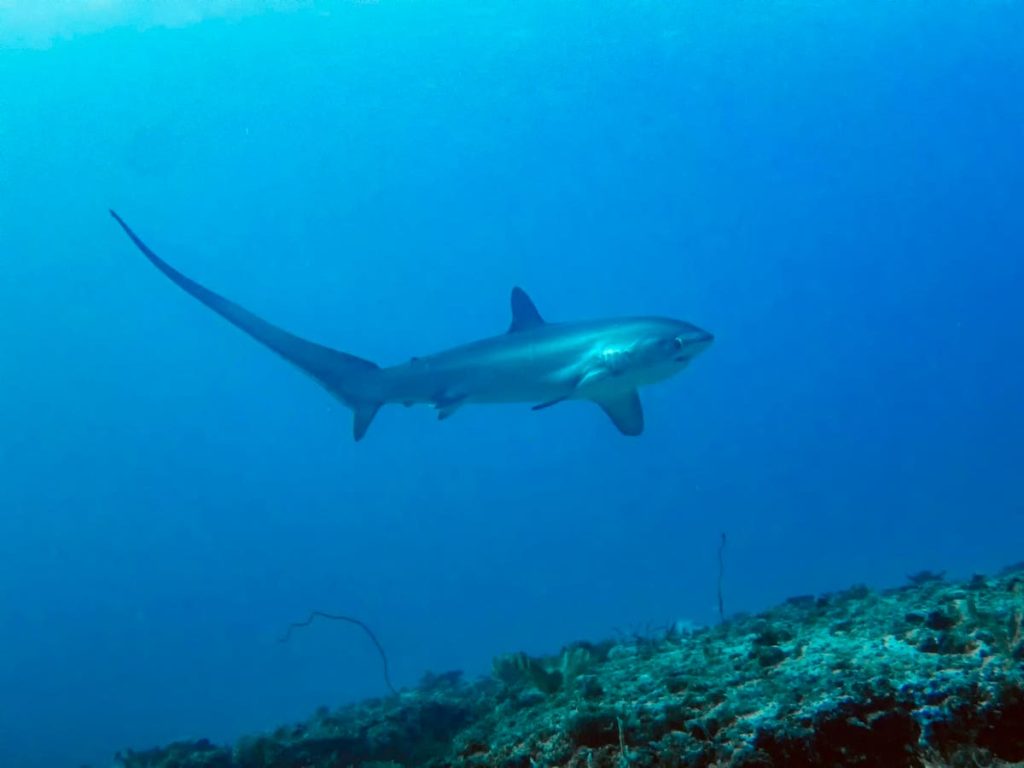Off Alor Island in the vast Indonesian archipelago, researchers and conservationists are using tagging technology to track endangered pelagic thresher sharks (Alopias pelagicus), many of which are juveniles or pregnant females.
The pelagic thresher shark’s long tail can reach several meters in length, stunning or killing prey in a whipping motion, but Rafid Shidqi, Co-Founder and Director of Thresher Shark Indonesia says their population has significantly declined over the past decades due to hunting, and there have been no regulations for protecting them in Indonesia, leaving them on the brink of extinction.
Shidqi and his colleagues have been working with the local community on Alor Island since 2018 to improve their perception and interaction with the animal, which have been seen for more than 50 years as a source of protein in the local diet.
“Alor has been identified as one of the thresher shark fishing hotspots in Indonesia, where 80% of caught sharks are pregnant females,” he says, “Our goal is to protect the endangered pelagic thresher sharks while protecting the rights of communities to livelihood.”
Shidqi co-founded Thresher Shark Indonesia with other young conservationists in Indonesia and they are using acoustic tagging to conduct research on the critical habitat of the sharks and use the information to create site-specific protection within Alor Marine Protected Area.
“We work with local communities to understand their dependency on the species and discuss potential alternative livelihoods through voluntary incentives,” he says, “Only fishers who wished to transition to alternative livelihoods will be given incentives like capital to start new businesses, equipment, and training.”
Shidqi says progress in training future indigenous conservation leaders has been slow and sometimes difficult, particulary due to the political conflict happening in the village.
“While people are initially receptive to the conservation and willing to shift to alternative livelihoods, they keep getting external influence from actors (e.g., political leaders, families, etc.) to continue fishing for sharks,” he says.
Origins Far From The Sea
Shidqi grew up in the small city of South Tangerang on the outskirts of the Jakarta, Indonesia.
“It’s a place where the ocean is very distant and although I’ve never grown up around the ocean but have always been fascinated by it since I was very little,” he says, adding that ocean conservation was never seen as a career option in his traditional Indonesian family where being an engineer or doctor instead was the preferred career choice.
Shidqi ended up completing a marine biology degree for his undergraduate degree, exposing him to various interesting realities of the ocean and its surroundings and its unique dynamic with local communities.
“I started my internship journey with the Lamakera Project — a project that aims to transition traditional manta ray hunting communities to alternative livelihoods, which has inspired me to continue working on the intersection of ocean conservation and human wellbeing,” he says.
Shidqi, who is also a Fellow of the New England Aquarium’s Marine Conservation Action Fund (MCAF), says that conservation has traditionally been a top-down approach: limiting the use of natural resources through the exclusion of people.
“This practice has to change with the integration of native understanding from conservationists and scientists from the Global South because conservation needs to be equitable and fair,” he says, adding that science from the Global South needs to incorporate this understanding and represent more knowledge in the space.
“For Indonesia especially, natural resource use has been a practice for many generations, especially in indigenous communities that have been practicing responsible natural resource extraction for many centuries,” he says.
Another shark researcher from the Global South is Andres Lopez, 42, is a Costa Rican marine biologist and co-founder of conservation NGO Mision Tiburon.
For Lopez, the most important project of the organization is the strengthening of the Scalloped Hammerhead Shark Sanctuary, which was formally declared by the Costa Rican government in 2018, protecting 10,000 acres of critical nursery habitat for the endangered scalloped hammerhead shark.
Read the full article here










